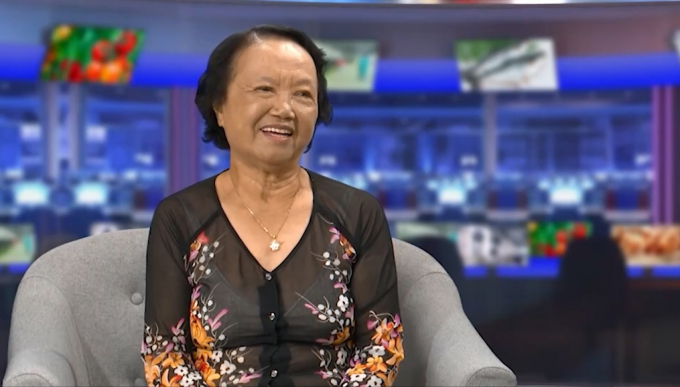November 27, 2025 | 22:41 GMT +7
November 27, 2025 | 22:41 GMT +7
Hotline: 0913.378.918
November 27, 2025 | 22:41 GMT +7
Hotline: 0913.378.918

Dr. Nguyen Thi Tram, Hero of Labor, People's Teacher, Vietnam National University of Agriculture (VNUA).
Over the past few years, Vietnam’s hybrid rice has acquired high adaptability and yield even in harsh-conditions regions such as Northern Midlands and Mountains and the Northern Central.
Along with the expansion of cultivation acreages, the structure of hybrid rice varieties also experiences strong development and becomes more varied and diverse, fundamentally meeting the requirements of many ecological zones with different climatic conditions and farming practices.
The varieties are of high quality with many strong traits, resilient to pests, diseases and other external conditions so farmers have many suitable options to choose from and put into production. A lot of hybrid rice varieties have been officially recognized including those selected and created by domestic establishments such as VL20, TH33, TH34, TH72,…
During winter-spring crops, most of the varieties are suitable and safe for sowing, bringing high yields. In the early crops (summer-autumn crops), hybrid rice has affirmed its position on the rice fields of northern provinces as well as the South Central Coast thanks to the features of short duration (90-100 days), high productivity and low susceptibility to leaf blight which make it compatible with the late spring/early crops structure.
Owning to the rich structure, adaptive to many ecological zones, the productivity of hybrid rice is on a constant rise. Reality through the years has shown that hybrid rice has a 10 - 12% higher yield than purebred rice under the same growing conditions. Many areas of hybrid rice reach 9 - 10 tons/ha, some places even reach the highest of 11-14 tons/ha. Hybrid rice has contributed to stabilizing social security and narrowing the development gap between regions.
In the early 90s, Dr. Nguyen Thi Tram, Hero of Labor, People's Teacher, Vietnam National University of Agriculture (VNUA), were among the first five Vietnamese sent by the state to Hunan, China to study hybrid rice techniques. Prof. Yuan Long Ping - the father of hybrid rice - directly taught this class.
The year 1992 was the first time she had access to hybrid rice technology. Back then, FAO had a support program for Vietnam so that the country could approach hybrid rice technology from China. Within the program, a group was established to study in China. Her group consisted of five members. Deputy Prime Minister Nguyen Cong Tan, who was the Minister of Agriculture at that time, assigned five people from five agencies. She was VNUA’s representative, carrying the mission to later return to teach and train agricultural technicians on hybrid rice.
Fortunately, this was the first class so only five Vietnamese and one Indian could attend. China is assigned by FAO, and therefore FAO held control of the program. Teacher Yuan Long Ping had written a curriculum to properly convey his knowledge to them. He directly gave lessons on three topics. This was an intensive class, with three topics in one whole pack, so he gave them a summary of the hybrid rice research and development situation in China, hybrid rice development strategy following three systems: the three-line system, two-line system, and one-line system. It was so fascinating to listen to. And in the final lesson he proposed a strategy to develop “super rice” and “super hybrid rice”. He gave them those three great lectures, and the others were from the staff of Hunan Hybrid Rice Research Centre (HHRRC).
After the study trip, apart from gaining knowledge through the curriculum, the group also learned a lot of things that they didn't teach, like the creation of seed in the fields, how it could be done, how should we observe the process,… Many old cadres from Chinese institutes and schools came to the centre to study, so they were able to learn a lot of things there.
In general, the heterosis of hybrid rice, as we all know, is portraited in many aspects. In the beginning we exploited hybrid vigor in the direction of yield improvement and shortening of growth time. The next generation had its tolerance heightened specifically towards blight, against planthoppers, and later rice blast. And the following generation that we're after will be of high productivity, yield and tolerance.
We are striving to seek cooperation with Cuong Tan Co., Ltd in order to discover the perfect time for the crop, GA3 spraying methods, and the path to mechanization in hybrid seed production. The goal is to further reduce the price, raise competitiveness, expand the planting acreage and lessen foreign importation.
Dr. Nguyen Thi Tram, Hero of Labor, People's Teacher, VNUA
Translated by Samuel Pham

(VAN) According to Mr. Vo Minh Thanh, Director of the Tay Ninh Department of Agriculture and Environment, Resolution 57 has created a new development pathway for the locality, shifting from traditional toward modern agriculture.
/2025/11/26/4909-2-154329_878.jpg)
(VAN) Pearl grouper farming in HDPE cages not only delivers economic efficiency but also contributes to protecting the environment, creating jobs, and promoting marine-based experiential tourism.

(VAN) The model of making a living under the forest canopy through the agroforestry system in Van Son commune, Bac Ninh province, is expected to generate an annual income of approximately VND 30 million/ha.

(VAN) Many enterprises in Can Tho are harnessing natural energy and reducing greenhouse gas emissions in their production processes, thereby contributing to the promotion of a sustainable green transition.
/2025/11/24/3536-2-112800_176.jpg)
(VAN) Dong Nai now has tens of thousands of hectares of forests certified for sustainable management, and this area will continue to be expanded in the coming period.

(VAN) Vinh Ha hamlet (Dai Xuyen commune, Hanoi) is shifting away from small-scale farming as households adopt bioscurity into their breeder chicken models.

(VAN) Heavy rains make aquatic species more vulnerable to disease. Proactive water management and high-tech systems help farmers prevent outbreaks and protect yields.